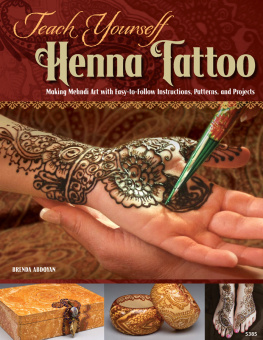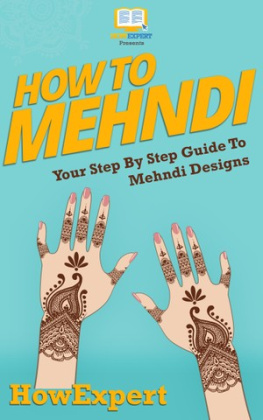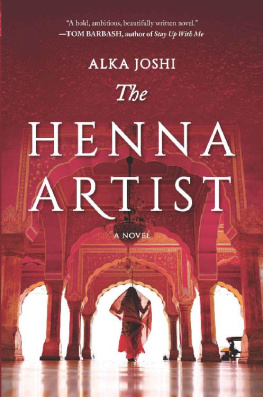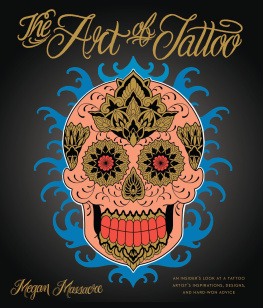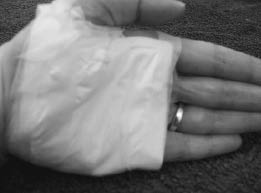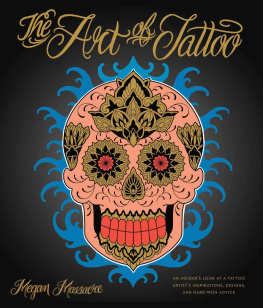Brenda Abdoyan - Teach Yourself Henna Tattoo: Making Mehndi Art with Easy-to-Follow Instructions, Patterns, and Projects
Here you can read online Brenda Abdoyan - Teach Yourself Henna Tattoo: Making Mehndi Art with Easy-to-Follow Instructions, Patterns, and Projects full text of the book (entire story) in english for free. Download pdf and epub, get meaning, cover and reviews about this ebook. year: 2012, publisher: Design Originals, genre: Home and family. Description of the work, (preface) as well as reviews are available. Best literature library LitArk.com created for fans of good reading and offers a wide selection of genres:
Romance novel
Science fiction
Adventure
Detective
Science
History
Home and family
Prose
Art
Politics
Computer
Non-fiction
Religion
Business
Children
Humor
Choose a favorite category and find really read worthwhile books. Enjoy immersion in the world of imagination, feel the emotions of the characters or learn something new for yourself, make an fascinating discovery.
- Book:Teach Yourself Henna Tattoo: Making Mehndi Art with Easy-to-Follow Instructions, Patterns, and Projects
- Author:
- Publisher:Design Originals
- Genre:
- Year:2012
- Rating:3 / 5
- Favourites:Add to favourites
- Your mark:
Teach Yourself Henna Tattoo: Making Mehndi Art with Easy-to-Follow Instructions, Patterns, and Projects: summary, description and annotation
We offer to read an annotation, description, summary or preface (depends on what the author of the book "Teach Yourself Henna Tattoo: Making Mehndi Art with Easy-to-Follow Instructions, Patterns, and Projects" wrote himself). If you haven't found the necessary information about the book — write in the comments, we will try to find it.
Color your world with the fabulous art of henna tattoo!
- Over 60 designs to try, test, and combine, with included templates & helpful tips
- Recipe to make your own hennahas been tested and perfected to get deep, lasting color
- Practice exercises with step-by-step instructions for 5 basic, simplified shapes to repeat and combine for an endless variety of mehndi designs
- Mehndi is a temporary tattoo, perfect for those just starting to think about permanent body art
- Versatile applications: Learn how henna can also be used to adorn wood, leather, and other surfaces
Mehndi, also known as henna tattoo, is a traditional Middle Eastern art used to adorn the body for weddings and other special celebrations. Today, you can join in the beauty and fun of mehndi with this simple book of patterns and instructions for the bodyand even home Dcor objects!
Inside Teach Yourself Henna Tattoo, you will find a variety of original henna tattoo patterns that can be applied to the hands, feet, belly and back. Youll also be encouraged to create your own designs by following the simple instructions for the 5 basic henna shapes, learning how to combine them in a variety of ways to create exotic mehndi designs of your own.
But why stop there? Mehndi is a versatile art that can also be applied to wood, leather, and other surfaces! Follow along with author and highly acclaimed mixed-media artist Brenda Abdoyan as she shows how she creates one-of-a-kind designs for a wooden box, leather pouch, magnet, tea caddy, and more.
Filled with stunning photographs of beautiful henna tattoo, this book is sure to inspire!
Brenda Abdoyan: author's other books
Who wrote Teach Yourself Henna Tattoo: Making Mehndi Art with Easy-to-Follow Instructions, Patterns, and Projects? Find out the surname, the name of the author of the book and a list of all author's works by series.

